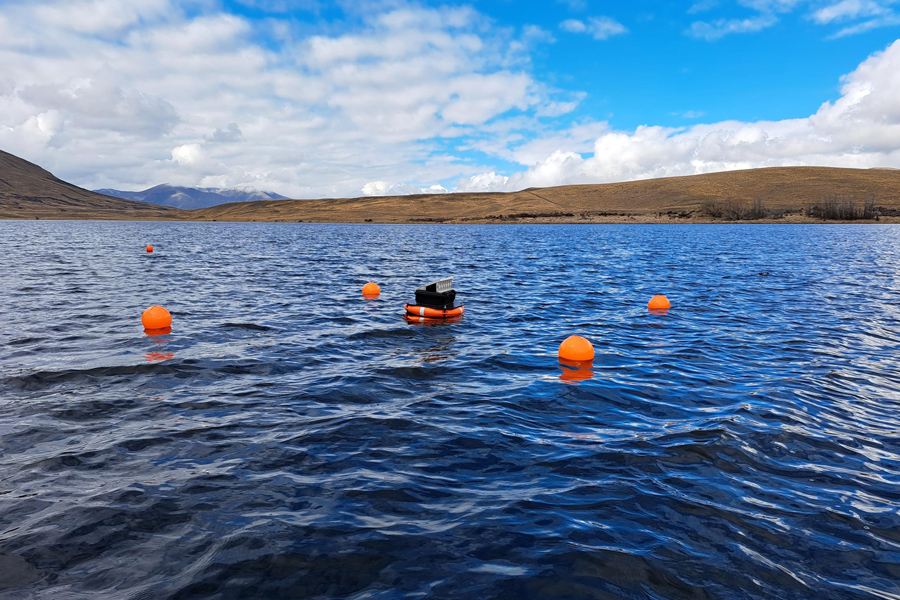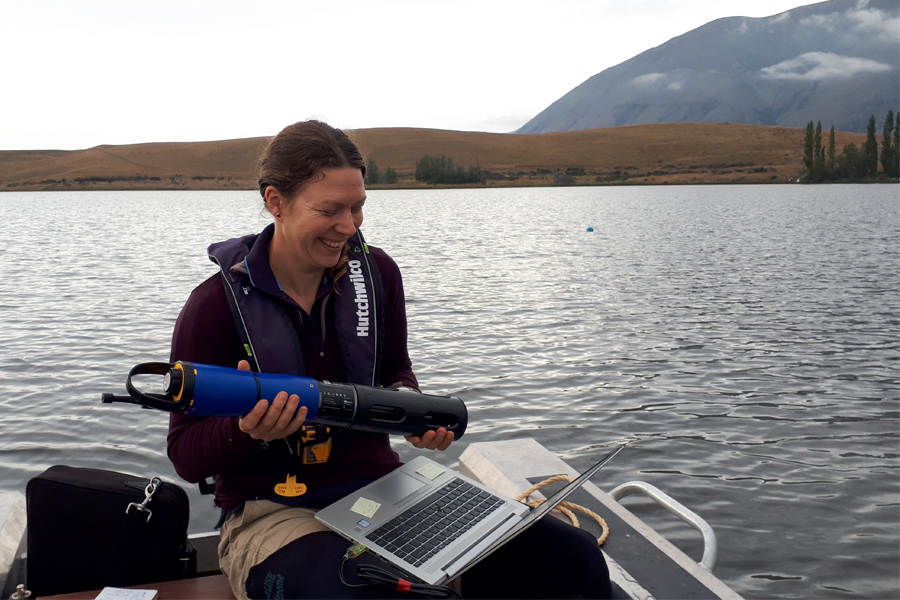Water quality monitoring in the Ōtūwharekai basin
We run several programmes that monitor water quality in the Ōtūwharekai basin. Monitoring helps us build a long-term picture of a lake’s health – including detecting any changes of concern. Sharing the data publicly helps the community to stay informed.
Our monitoring programmes
Our monitoring programmes include:
- Long-term regular water quality monitoring across eight lakes (monthly from December to April every year)
- Monthly stream monitoring at Hakatere/Ashburton River
- Aquatic ecosystem health monitoring at three sites once a year
- Recreational water quality monitoring at Ōtautari/Lake Camp and Te Puna a Taka/Lake Clearwater weekly over the summer swimming season (December to March)
- Newer, short term water quality investigations which are designed to answer a specific question or fill gaps in our knowledge.
- Continuous nitrate monitoring in Gentleman Smith Stream
- Monthly on-lake monitoring of Ō Tū Roto/Lake Heron and Te Puna a Taka/Lake Clearwater
- Continuous water quality monitoring of Ō Tū Roto/Lake Heron and Te Puna a Taka/Lake Clearwater
- Monitoring of lake water levels of Te Puna a Taka/Lake Clearwater, Kirihonuhonu/Lake Emma and Ō Tū Roto/Lake Heron
- Monitoring of groundwater in the Māori Lakes catchment.
Some of this data is available on our website, and on Land Air Water Aotearoa (LAWA):
- Land Air Water Aotearoa (LAWA) collates our water monitoring data to provide long-term swimming grades.
- Land Air Water Aotearoa (LAWA) collates our long term water monitoring data to show ecosystem health for long-term sites.
Other sources of data
- Department of Conservation (DOC) undertakes monthly monitoring of stream water quality at 12 sites.
Why we monitor lake water quality continuously
We monitor lake water quality to give us a picture of what’s going on in the area and:
- because there is a regulatory requirement for continuous data (e.g. Dissolved oxygen under National Policy Statement of Freshwater Management)
- to understand the potential impacts of climate change
- to understand the timing and length of thermal stratification and its impacts on lake ecosystems. Thermal stratification, or thermal layering, is when water near the lake surface warms in summer, resulting in a cool bottom water layer and a warmer top layer. The length and stability of stratification has major effects on lake ecology through influencing the availability of light, nutrients and oxygen to organisms.
What we look for at Te Puna-a-Taka/Lake Clearwater
Continuous or high-frequency water quality monitoring usually involves automated water quality monitoring stations with sensors recording a data point every 15 minutes.
Not all water quality parameters can be monitored continuously. For instance, nutrient concentration at environmental levels cannot (yet) be measured continuously (with the exception of nitrate).
At our continuous lake water quality stations at Te Puna-a-Taka/Lake Clearwater, we look at a number of water quality attributes and parameters.
Chlorophyll a - algal biomass
The measurement of Chlorophyll a gives an indication of the amount of algae in the water. While algae are the basin of the aquatic food chain, an overgrowth of algae can lead to green, turbid (murky) water, low oxygen at the lakebed, and loss of habitat.
Turbidity - water clarity
Turbidity is a measure of water clarity, which determines the amount of light that reaches the lakebed - allowing aquatic plants to grow. Aquatic plants are essential for a healthy lake ecosystem as they stabilise the lakebed and remove nutrients from the water that would otherwise be used by algae to grow. Turbidity is affected by sediment in the water and algae in the water. High wind speeds can cause re-suspension of sediment from the lakebed (i.e. strip-up the lake bed).
Dissolved oxygen at the lakebed
This measurement gives an indication of habitat quality, and also the potential for nutrient release from lake sediments. Aquatic animals require oxygen to breathe, and animals such as fish and kākahi/freshwater mussels need concentrations above 4 mg/L dissolved oxygen to thrive. Measurements of less than 2 mg/L can also trigger the release of nutrients though chemical reactions that occur in the absence of oxygen.
Meteorological parameters
Wind speed, air temperature, and rainfall are measured at the monitoring station or at nearby weather stations. These parameters are drivers of water temperature, turbidity, algal growth and other in-lake processes.
What the results tell us
Te Puna-a-Taka/Lake Clearwater – water monitoring data
Continuous chlorophyll a is not an official reading: it’s an in-situ estimate and cannot be used in the same way as chlorophyll a results from a laboratory. For instance, it cannot be used to calculate TLI.
- Algal biomass is usually lower in winter than in summer, due to colder water temperatures and less sunlight
- Algal biomass (measured as Chlorophyll a) often increases over spring and summer with warmer water temperatures.
- Water temperatures in summer can exceed 20 degrees which is above optimum temperatures for many species of fish.
When the lake stratifies, bottom dissolved oxygen reduces very low very quickly due to a small water volume in the deep part of the lake.
Periods of lake summer stratification usually only last for a number of days. But;
- There is a risk of total oxygen loss with longer calm periods. Should this happen, we can expect to see nutrient release from the lake sediments.
- In summer, dissolved oxygen periodically went below the threshold for kākahi and fish health in the deep basin. Generally speaking, at 600m altitude, concentrations below 55% are considered to negatively impact fish health.
Lakes at high altitudes can undergo a reverse, ‘winter’ stratification when ice forms at the surface of the lake. Unlike other fluids, water is heaviest at 4 degrees, due to a density anomaly. Therefore, water at 4 degrees sinks to the bottom of the lake, while colder water (less than 4 degrees) remains at the top.
As a result, dissolved oxygen can decrease at the lake bed. In Lake Clearwater, surface temperatures dropped below 4 degrees and ice formed on the lake surface, and we observed oxygen loss to a small extent.


